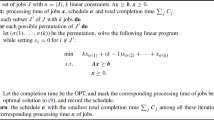Abstract
We investigate several classes of inequalities for the symmetric travelling salesman problem with respect to their facet-defining properties for the associated polytope. A new class of inequalities called comb inequalities is derived and their number shown to grow much faster with the number of cities than the exponentially growing number of subtour-elimination constraints. The dimension of the travelling salesman polytope is calculated and several inequalities are shown to define facets of the polytope. In part II (“On the travelling salesman problem II: Lifting theorems and facets”) we prove that all subtour-elimination and all comb inequalities define facets of the symmetric travelling salesman polytope.
Similar content being viewed by others
References
C. Berge,Graphs et hypergraphs (Dunod, Paris, 1970).
V. Chvátal, “Edmonds polytopes and weakly Hamiltonian graphs”,Mathematical Programming 5 (1973) 29–40.
G.B. Dantzig, D.R. Fulkerson and S.M. Johnson, “Solution of a large-scale travelling salesman problem”,Operations Research 2 (1954) 393–410.
J. Edmonds, “Maximum matching and a polyhedron with 0, 1 vertices”,Journal of Research of the National Buruea of Standards Sect. B 69 (1965) 125–130.
J. Edmonds and E.L. Johnson, “Matching: A well-solved class of integer linear programs”, in R.K. Guy, H. Hanani, N. Sauer and J. Schonheim, eds.,Combinatorial structure and their applications (Gordon and Breach, New York, 1970) pp. 89–92.
R. Garfinkel and G.L. Nemhauser,Integer programming (Wiley, New York, 1972).
R.E. Gomory, “The travelling salesman problem”, in:Proceedings of the IBM Scientific Computing Symposium on Combinatorial Problems, IBM Data Processing Division (White Plains, NY, 1964).
M. Grötschel, “Polyedrische Charakterisierungen kombinatorischer Optimierungsprobleme”, Dissertation, Universität Bonn, 1977 (Verlag A. Hain, Meisenheim, 1977).
M. Grötschel, “Further results on the facial structure of the travelling salesman polytope”, IX International Symposium on Mathematical Programming (Budapest, August 1976).
M. Grötschel and M.W. Padberg, “Linear characterizations of travelling salesman problems”, EURO-I, First European Congress on Operations Research (Brussels, January 1975).
M. Grötschel and M.W. Padberg, “Zur Oberflächenstruktur des Travelling Salesman Polytopen”, in: H.J. Zimmermann, A. Schub, H. Späth and J. Stoer, eds.,Proceedings in Operations Research, 4 (Physica-Verlag, Würzburg, 1974) pp. 207–211.
M. Grötschel and M.W. Padberg: “On the travelling salesman problem”, Joint National Meeting of ORSA and TIMS (Las Vegas, November 1975).
M. Grötschel and M.W. Padberg, “Lineare Charakterisierungen von Travelling Salesman Problemen”,Zeitschrift für Operations Research 21 (1977) 33–64.
M. Grötschel and M.W. Padberg, “Partial linear characterizations of the asymmetric travelling salesman polytope”,Mathematical Programming 8 (1975) 378–381.
M. Grötschel and M.W. Padberg, “On the symmetric travelling salesman problem”, Report No. 7536-OR, Inst. für Ökonometrie und Operations Research, Universität Bonn (Bonn, 1975).
M. Grötschel and M.W. Padberg, “On the symmetric travelling salesman problem II: Lifting theorems and facets”,Mathematical Programming 16 (1979) 281–302 (this issue).
F. Harary,Graph theory (Addison-Wesley, Reading, MA, 1972).
I. Heller, “On the problem of shortest paths between point”, I and II (Abstract),Bulletin of the American Mathematical Society 59 (1953) 551–552.
I. Heller, “Neighbor relations on the convex of cyclic permutations”,Pacific Journal of Mathematics (1956) 467–477.
S. Hong, “A linear programming approach for the travelling salesman problem”, Ph.D. Thesis, The Johns Hopkins University (Baltimore, 1971).
R.M. Karp, “Reducibility among combinatorial problems”, in: R.E. Miller and J.W. Thatcher, eds.,Complexity of computer computations (Plenum Press, New York, 1972) pp. 83–103.
H.W. Kuhn, “On certain convex polyhedra” (Abstract),Bulletin of the American Mathematical Society 61 (1955) 557–558.
J.F. Maurras, “Polytopes à sommets dans [0, 1]n”, Thèse, University of Paris (Paris, 1976).
K. Menger, “Botenproblem”, in: K. Menger, ed.,Ergebnisse eines mathematischen Kolloquiums (Wien 1930), Heft 2 (Leipzig, 1932) pp. 11–12.
E. Netto,Lehrbuch der Combinatorik (Chelsea Publishing Company, New York).
R.Z. Norman, “On the convex polyhedra of the symmetric travelling salesman problem” (Abstract),Bulletin of the American Mathematical Society 61 (1955) 559.
M.W. Padberg and S. Hong, “On the symmetric travelling salesman problem: A computational study”, T.J. Watson Research Report, IBM Research (Yorktown Heights, 1977).
M.W. Padberg and M.R. Rao, “The travelling salesman problem and a class of polyhedra of diameter two”,Mathematical Programming 7 (1974) 32–45.
J. Stoer and Ch. Witzgall,Convexity and optimization in finite dimensions I (Springer, Berlin 1970).
Author information
Authors and Affiliations
Rights and permissions
About this article
Cite this article
Grötschel, M., Padberg, M.W. On the symmetric travelling salesman problem I: Inequalities. Mathematical Programming 16, 265–280 (1979). https://doi.org/10.1007/BF01582116
Received:
Revised:
Issue Date:
DOI: https://doi.org/10.1007/BF01582116




